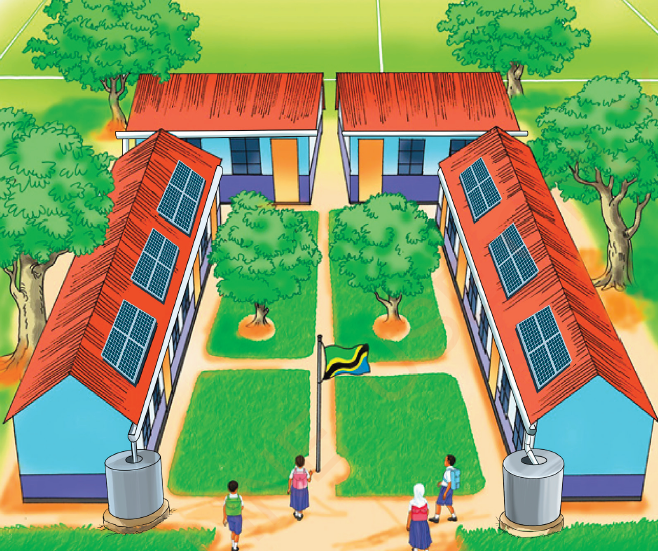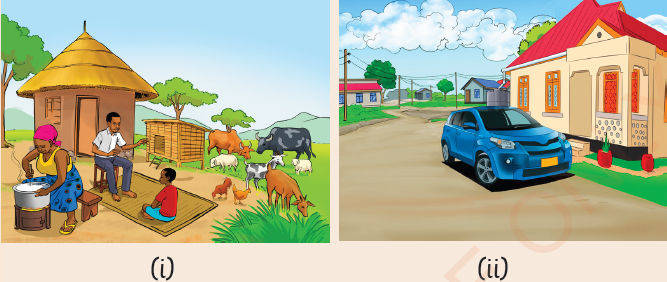Chapter 01 : The concepts of Geography and the Environment
| Introduction Human beings need to understand the relationship between Geography and the Environment so that they know the best ways to interact with their surroundings. Geography enables human beings to understand the surrounding environment and to conserve and use it sustainably. In this chapter, you will learn about the meanings, interaction and importance of learning Geography and the Environment. The competencies to be developed will enable you to value and care for the environment. |
Think
Things that surround human beings
Meaning of Geography
Geography is a subject that deals with the study of human beings and their environment. Geography is concerned with the earth, the atmosphere and things that exist on the earth’s surface. Geography is also concerned with the distribution of things and their interaction with human beings. The earth’s surface comprises the continents and the oceans. The continents and the oceans have various features which constitute the environment. Hence, Geography enables human beings to develop the basic skills that enable them to understand and interact with the environment in
a sustainable way. Figure 1 illustrates the earth’s surface.
|
Figure 1: Earth’s surface |
Meaning of the environment
On the earth’s surface, human beings are surrounded by various things. These things and human beings are part of the environment. Therefore, the environment includes all the things that surround human beings. The things that surround human beings can be either natural or man-made. Natural things are those which are not created by human beings such as mountains, plants, animals, rivers, land and air. Man-made things include houses, roads, gardens, tables, cars and other things that are not natural. Information about the components that form the
environment is summarized in Figure 2.
|
Figure 2: Components of the environment |
Natural and man-made things can be found at home, school or elsewhere. Human beings depend on the environment for various activities that enhance their living. Thus, human beings are responsible for taking care of and conserving the environment. Figure 3 shows some of the things found in the environment.
|
Figure 3: Some of the things that form the environment |
Our school environment
Activity 1
Observe various things found in your school environment, then:
1. Identify the natural and man-made things you have observed.
2. Explain the benefits of the things you have identified.
A school environment consists of all the things found at the school. These things are like classrooms, teachers’ offices and houses, trees, flower gardens, play grounds, the
national flag and toilets. Other things found in the school environment are dormitories, a library, laboratories and natural things such as rivers and hills. Inside the classroom
there are desks, chairs, tables, books, a board and other teaching and learning materials. In addition, pupils, teachers and other staff are part of the school environment.
The environment of one school may be different from or similar to that of another school, depending on the specific things found in a school. Basically, the things found in a school environment are important in teaching and learning processes; thus, they have to be cared for.
Activity 2
Observe Figure 4 and then answer the questions that follow:
|
Figure 4: School environment |
Questions
1. What do you see in Figure 4?
2. What essential things, if removed from the school environment shown in Figure 4 would affect that environment? Give reasons.
Home environment
Activity 3
Observe Figure 5 and answer the questions that follow:
|
Figure 5: Home environment |
Questions
1. What do you see in Figure 5?
2. Which of the things in Figure 5 are found in your home?
The home environment includes all the things found at home. These things can be inside or outside the house. The environment outside the house may include trees, flowers, birds, insects, animals, rivers, mountains, valleys and other things, depending on where one lives. The indoor environment may include beds, couches, cooking utensils, cleaning tools and other things found in the house. The environment is often similar or different, depending on the things found in a given area. Therefore, it is not necessary for one’s home environment to be the same as another’s. Similarly, the environment of a particular area does not necessarily have to be the same as that of another.
Exercise 1
1. Differentiate a home from a school environment.
2. A home environment may change according to the various activities undertaken at home.
(a) Explain the activities that may help to create a beautiful home environment.
(b) Explain the activities that may destroy your home environment.
Activity 4
On your way to school, do the following:
1. Observe the environment.
2. Identify the things you see.
3. From your observation, what things are not found at your home environment?
Relationship between Geography and the Environment
Geography and the Environment are related concepts that are difficult to separate. We have learnt that the environment encompasses all the things that surround us, while Geography explains those things. Therefore, Geography helps us to understand the environment
that surrounds human beings and how to interact with them. Things like the forests, mountains, lakes, rivers,
oceans, weather, land and animals around human beings constitute what we call is Geography and the Environment
as a discipline. Therefore, it is important to study both at the same time.
Activity 5
Observe Figure 6 and answer the questions that follow:
|
Figure 6: Human activities |
Questions
1. What activities are carried out in Figure 6?
2. Where are the activities carried out? Explain
3. Which of the activities seen in Figure 6 are undertaken in the environment you live in?
4. Why are some of the activities in Figure 6 not undertaken in the environment you live in?
Importance of learning Geography and the Environment
Learning Geography and the Environment enables us to understand our surroundings. It also helps us to recognize the resources we have in our environment and how to use, conserve and manage them. Examples of such resources are wildlife, rivers, lakes, oceans, forests, land, minerals and mountains.
Similarly, learning Geography and the Environment enables us to understand the human activities that can be undertaken in different areas. For example, in areas with rivers, lakes and oceans, fishing or tourism can be practised. Plain land is mostly used for agriculture and livestock keeping. Lumbering and beekeeping are undertaken in areas with forests.
Furthermore, learning Geography and the Environment enables us to understand the local weather condition of a particular area. For example, an area dominated by trees often has pleasant weather and is attractive. In addition, mountainous areas may have cooler weather due to the high altitude; thus people need to wear thick clothes like sweaters when they are in such areas.
Coastal areas often have warmer weather than inland areas. Therefore, those in warm coastal areas can wear lighter clothing to avoid or reduce the effects of heat. However, the temperature in coastal areas can vary depending on the elevation of land and the direction of winds. Geography and the Environment helps us to identify natural hazards such as floods, earthquakes and hurricanes, and how to avoid their effects on people and their property.
Geography and the Environment also assists us in planning and building infrastructure and social services. Examples of infrastructure and providing social services include roads, hospitals and schools. Thus, learning Geography and the Environment enables human beings to identify areas in need of such services. Generally, it is important to learn Geography and the Environment so as to plan for appropriate and sustainable use of the resources found in the environment. The resources can be water, forests and land.
Exercise 2
1. Why do we study Geography and the Environment?
2. What is the importance of having knowledge of natural hazards?
3. What natural resources are found in the environment you live in?
Revision Exercise
Choose the letter of the correct answer
1. Which of the following activities sustain our natural environment?
- Mining
- Managing and conserving the environment
- Building modern houses
- Setting up industries
2. What activities can you do other than fishing, if you live in an area with rivers, oceans and lakes?
- Irrigation farming
- Harvesting crops
- Timber processing
- Hunting and selling hides
3. Learning Geography and the Environment provide us with knowledge of .
- the relationship between human and the things that surround them
- humans ability of a human to make beehives
- how humans can organize the distribution of things in the environment
- the way humans make seine nets
4. The climate of one area may differ from that of another because of .
- people living in the area
- the relief and vegetation cover
- the animals present in the environment
- the insects in the environment
5. What are the resources essential for keeping bees?
- Water, leaves and rocks
- Trees, flowers and forests
- Mountains, valleys and oceans
- Rain, logs and leaves
6. What kind of weather do the coastal areas in Tanzania experience?
- Cold
- Cold and hot
- Hot
- Humid
7. If there was a river in your environment whose water is used for various purposes, what kind of knowledge from Geography and the Environment would enable you to ensure sustainable use of the river?
- Weather
- Environmental conservation
- Irrigation farming
- Fishing and tourism
Short answer items
8. What benefits do we get from planting trees in the school environment?
9. If your parents or guardians bought a big piece of land with a forest on it, what kind of activity would you advise them to undertake in that land?
10. What are the geographical and environmental factors that might guide you in selecting an area for undertaking agriculture?
11. Using the knowledge gained from Geography and the Environment, identify the appropriate land use in the environment you live in.
Vocabulary
Climate the weather condition experienced over a long period of time in a region always over 30 years
Garden an area planted with flowers, fruit trees, vegetables or shrubs
Hazard a phenomenon that may potentially cause the loss of people’s lives and property
Human activities various functions, tasks, works or actions that people do to achieve certain purposes
Infrastructure basic systems and structures such as roads, railways, banks or an hospitals that a country or an organization needs to function properly
Land the hard part of the earth that is not covered by water
Ocean a large body of salt water that covers most of the earth’s surface and surrounds its land masses
Resource a substance which provides products that are essential for human life
Weather the atmospheric condition experienced over a short period of time. It may be an hour, a day or a week
www.learninghubtz.co.tz
Hub App
 For Call,Sms&WhatsApp: 255769929722 / 255754805256
For Call,Sms&WhatsApp: 255769929722 / 255754805256
 For Call,Sms&WhatsApp: 255769929722 / 255754805256
For Call,Sms&WhatsApp: 255769929722 / 255754805256
WHATSAPP US NOW FOR ANY QUERY
App Ya Learning Hub Tanzania












